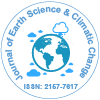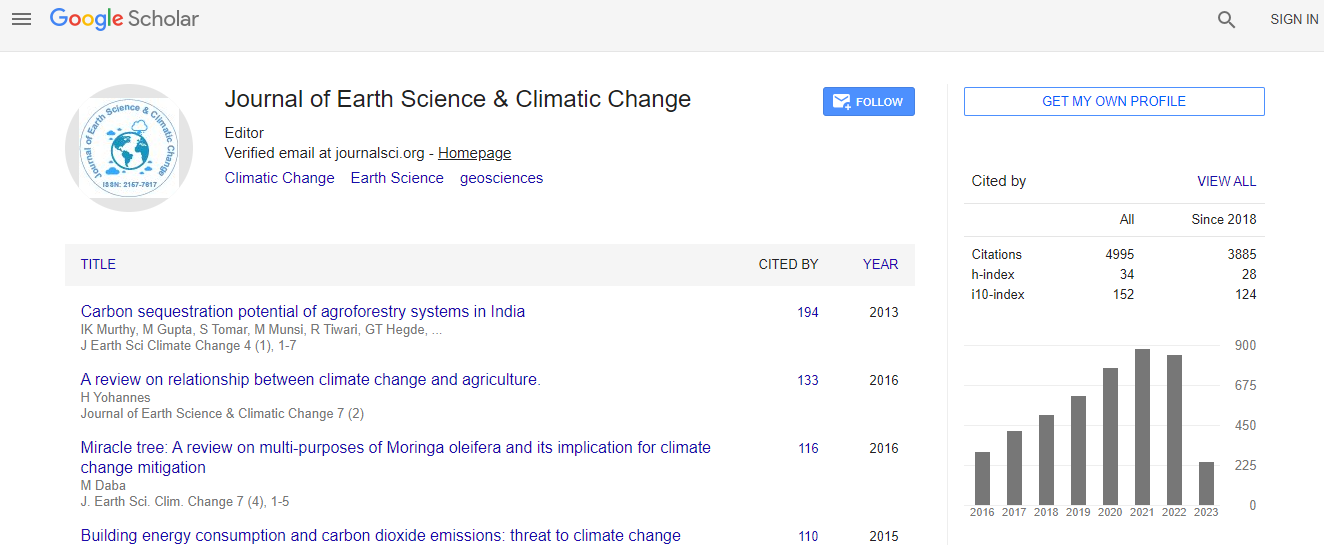Our Group organises 3000+ Global Conferenceseries Events every year across USA, Europe & Asia with support from 1000 more scientific Societies and Publishes 700+ Open Access Journals which contains over 50000 eminent personalities, reputed scientists as editorial board members.
Open Access Journals gaining more Readers and Citations
700 Journals and 15,000,000 Readers Each Journal is getting 25,000+ Readers
Google Scholar citation report
Citations : 5125
Journal of Earth Science & Climatic Change received 5125 citations as per Google Scholar report
Journal of Earth Science & Climatic Change peer review process verified at publons
Indexed In
- CAS Source Index (CASSI)
- Index Copernicus
- Google Scholar
- Sherpa Romeo
- Online Access to Research in the Environment (OARE)
- Open J Gate
- Genamics JournalSeek
- JournalTOCs
- Ulrich's Periodicals Directory
- Access to Global Online Research in Agriculture (AGORA)
- Centre for Agriculture and Biosciences International (CABI)
- RefSeek
- Hamdard University
- EBSCO A-Z
- OCLC- WorldCat
- Proquest Summons
- SWB online catalog
- Publons
- Euro Pub
- ICMJE
Useful Links
Recommended Journals
Related Subjects
Share This Page
In Association with

Impacts of climate change on agricultural technology management in the Transylvanian Plain, Romania
5th International Conference on Earth Science & Climate Change
Teodor Rusu
University of Agricultural Sciences and Veterinary Medicine of Cluj-Napoca, Romania
Posters & Accepted Abstracts: J Earth Sci Clim Change
Abstract
The condition of land degradation in Transylvanian Plain (TP) and its effects, being the result of local extreme physical-geographical conditions, susceptible to degradation (evidenced by the erodibility index), which overlap the extreme climatic conditions. Thermal and hydric regime monitoring is necessary in order to identify and implement measures of adaptation to the impacts of climate change. Soil moisture and temperature regimes were evaluated using a set of 20 data logging stations positioned throughout the plain. Each station stores electronic data of ground temperature at 3 depths (10, 30, 50 cm), the humidity at the depth of 10 cm, the air temperature (at 1 m) and precipitations. Climate change in the past few years have significantly altered the climatic indicators of the TP. Precipitations, although deficient in terms of annual amounts, through their regime, have a negative influence on the plant carpet. Pluvial aggressiveness index reveals, for the research period, a first peak of pluvial aggressiveness during the months of February-April, then in July and in autumn, the months of October-November. This requires special measures for soil conservation, both in autumn and early spring, soil tillage measures being recommended which ensure the presence of plant debris and vegetation in early spring but especially in summer and autumn. Climatic indicators determined for the period 2009-2014 point out, in TP, a semi-arid and mediterranean climate through the rain factor Lang, respectively semi-arid (in the South), semi-humid (in the North) according to the De Martonne index. This climatic characterization requires special technological measures for soil conservation.Biography
Email: rusuteodor23@yahoo.com

 Spanish
Spanish  Chinese
Chinese  Russian
Russian  German
German  French
French  Japanese
Japanese  Portuguese
Portuguese  Hindi
Hindi 
